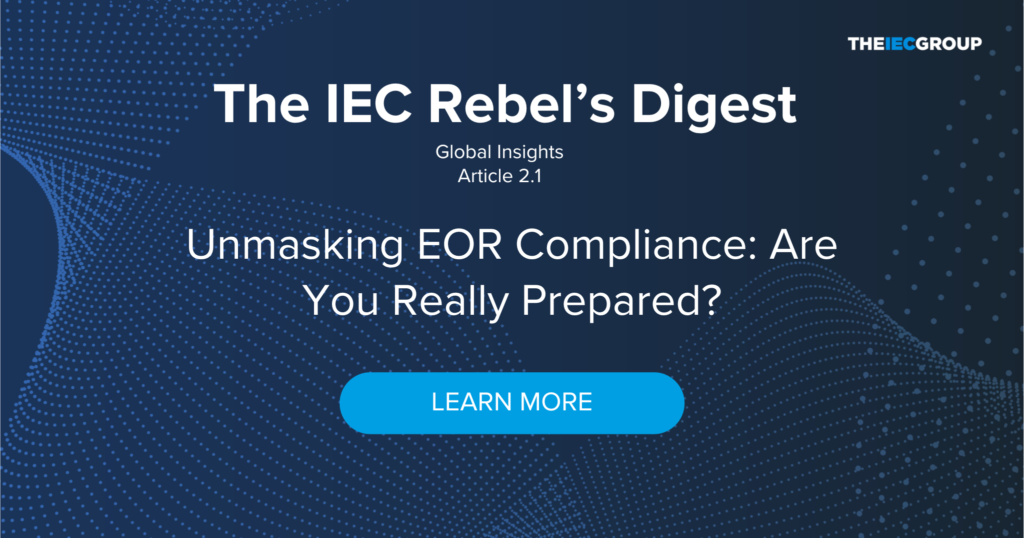Introduction
What do we really mean concerning global expansion and EOR when we state our partners or our operations must be “compliant”, or that they or we are x% compliant? A simple question, but one which has some surprisingly complex undertones and variations. You see, the understanding of what ”compliance” actually means varies.
For and EOR company there are three basic operational models which must be considered:
Direct, – where the EOR company employs the staff themselves under their own total control.
Indirect, – where the EOR company employs the staff at remote locations and manages them via partner companies it has contracts with, and
Hybrid, – a mix of the two above.
Understanding the importance of compliance in risk management is crucial for organizations seeking to mitigate potential legal and regulatory pitfalls. Compliance generally refers to adhering to laws, regulations, and industry standards applicable to a specific business or sector in a specific country or bloc of countries. It encompasses various areas such as regulatory requirements, right to work / visa requirements, labour laws, tax regulations, data privacy, health and safety protocols, ESG, etc. Failure to comply with these requirements can result in severe risk and damage to contracting companies’ businesses and even legal actions. By understanding the importance of compliance in risk management, businesses can proactively assess potential risks, develop robust internal controls, and ensure adherence to relevant laws. In the Direct model, this process involves internal controls and actions, resulting in a regularly reviewed checklist, potentially fully supported by advanced EOR platforms. In both Indirect and of course Hybrid models however, the process involves both internal compliance checking AND review and auditing partner company compliance processes in such a way that the EOR company and their customers can rest assured that all compliance steps are in place to the same level and standard as if only a pure Direct model was being used.
The Role of EOR Platforms In Enhancing and Ensuring Compliance
Advanced employer of record platforms play a significant role in enhancing compliance by providing comprehensive solutions that address various compliance requirements. This is crucial for organizations operating in today’s complex global legal and regulatory landscape. EOR platforms ensure that all employment contracts and agreements are drafted in accordance with local laws, ensuring legal compliance. These platforms may also provide comprehensive payroll services, guaranteeing accurate tax calculations and timely submissions, and stay current with ever-changing tax regulations. In this manner, EOR platforms mitigate the risk of non-compliance and potential penalties, while also actively monitoring changes in labour laws and regulations across different countries.
These platforms additionally offer advanced HR technology solutions that streamline administrative processes for both employers and employees facilitating efficient onboarding processes by managing documentation requirements, background checks, work permits, and other compliance-related tasks. By automating these processes, they save time while maintaining strict compliance standards. Advanced employer of record platforms provide real-time visibility into workforce data through robust reporting tools and can provide “tripwire” reporting when a situation changes, potentially making a situation non-compliant or illegal.
The Compliance and Response Test:
It is well known and accepted in the EOR industry, that the majority of issues challenging contractual obligation, contractual type and legal compliance, occur during the termination or separation phase of an employee (or group of them). Response time to interact with the employee or their legal counsel, with experts in the field and country, as well as having 100% correct contractual and working condition information regarding both the situation in general and that employee specifically is vital. Failure to respond rapidly, (often in hours or even minutes), in a cohesive manner, which is based on correct information, has proven to be the difference between costly lawsuits and reputational damage, or swift problem resolution.
The Compliance Quandary:
The overall quandary for any EOR company in ensuring 100% compliance and response when challenged, is of course the audit and checking of all of the above laws and regulations in any country they operate and offer their services within and the response mechanisms in place. Once established the continuous or highly regular monitoring of such laws and legal requirements, to ensure continued compliance, even thru highly regular adaptation and change, – which is witnessed in many countries. Those with modern and advanced EOR systems in place may well have such changes automatically being flagged or included within their systems operational parameters in an on-going process, others need to plan for manual audits and process changes as part of their daily business, if they wish to truly claim “100% compliance” at all times.
This brings us back to the original three models of operation. Direct, as outlined, is purely an internal to the EOR company process which can be planned in and constantly verified, but what of the other two models, (Indirect and Hybrid)? How are both the compliance AND response process guaranteed?
Key Takeaways:
- Not all compliance statements are equal.
- Knowing all compliance elements required and ensuring 100% compliance across so many countries and regions is tough (and can be expensive).
- Managing EOR partner ecosystem companies to ensure they remain in full compliance is tougher than pure Direct models. SLAs, KPIs, compliance statements, etc, is not enough to ensure there will be no reputational damage if things go wrong due to a partner company not being compliant. Monitoring and auditing IS required.
- Having a robust and rapid response to separation issues, with a “tiger team” of experts as well as standardised HR response, backed by 100% correct information is vital in ALL three operational models. Again, reputational (as well as financial) risk exists without this.


